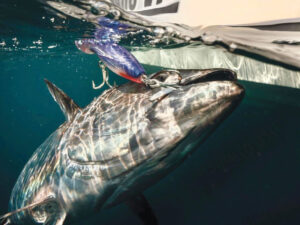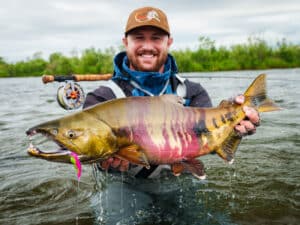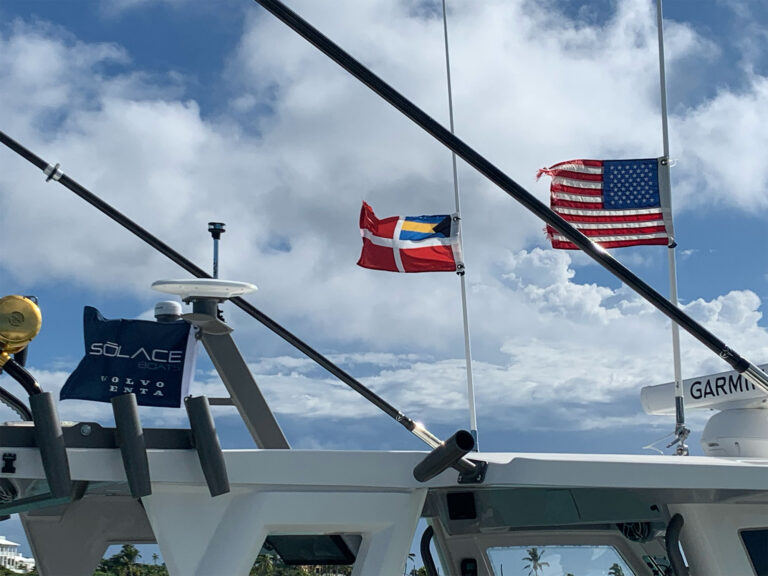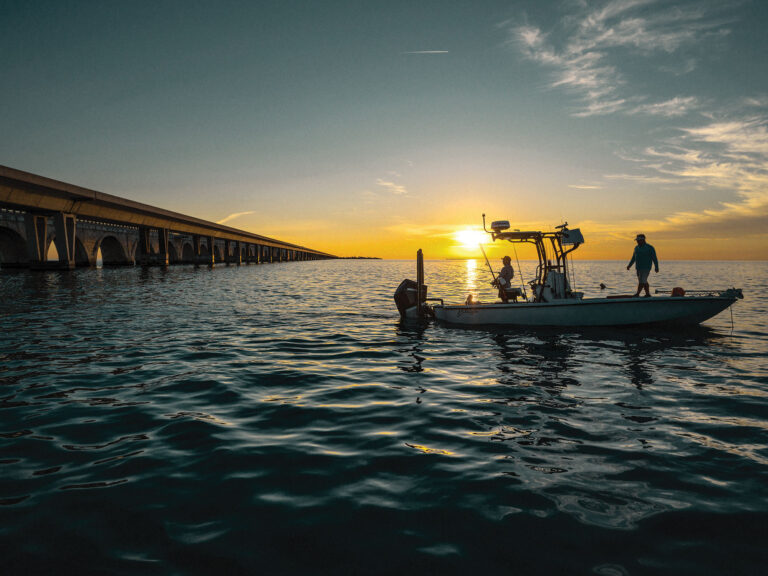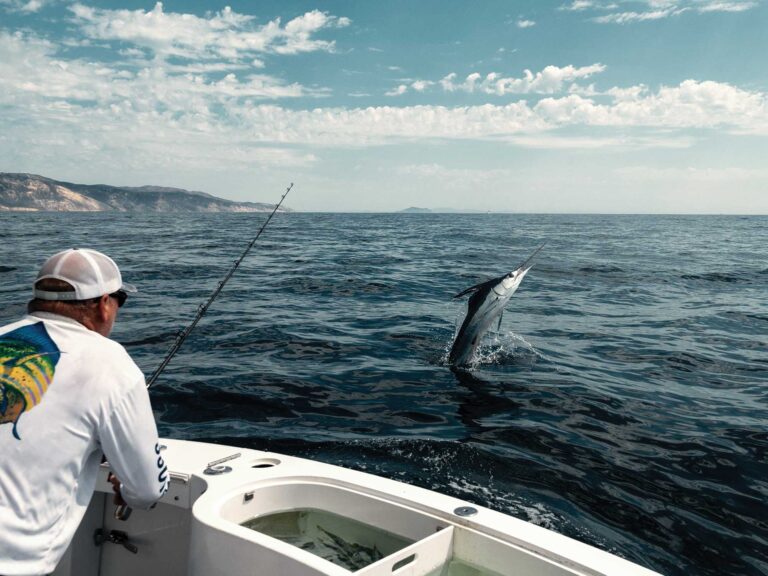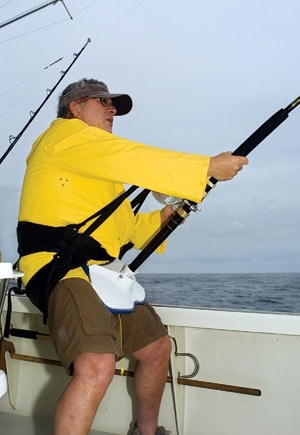
For truly large fish – giant tuna and grandermarlin – there is no better method of fighting them than from a chair in the cockpit of a big boat. But for more than 40 years, thanks to an innovative group of West Coast anglers and East Coast big-game enthusiasts, more anglers worldwide have been able to give up the chair and stand up for themselves.
Stand-up fishing originated on the decks of long-range tuna boats out of Southern California, where big yellowfin tuna, wahoo, striped marlin and a host of other pelagics were regular targets. Then, in the mid-1980s, a stand-up explosion occurred in the offshore world. Big-game anglers started chasing big marlin, sharks and giant bluefin tuna on stand-up. Today it continues to be one of the most effective ways to fight and land a variety of hard-fighting fish, and it gives anglers with limited space and resources the ability to land the fish of their dreams on a moment’s notice.
Why Stand Up?
One of the key advantages to stand-up tackle is the variety of species you can target. For our purposes, focus on 30- to 50-pound-class tackle – the most applicable line classes for the widest variety of anglers. Within reason, some of the biggest fish in the ocean can be taken on them. So why stand-up? South Florida big-game enthusiast Marsha Bierman was one of the anglers responsible for popularizing the technique during the 1980s. She loves the man-versus-fish aspect of fighting big fish – sans chair.
“Stand-up is more of a one-on-one between the angler and the fish,” says Bierman. “Plus you can start the fight faster than when transitioning into a chair, and you are able to use much lighter, easier-to-handle equipment as opposed to traditional, bulky trolling outfits.”
Several key elements give anglers a distinct advantage. First, shorter rods combined with low-riding fighting belts and harnesses allow fishermen to exert maximum pressure on fish by using their entire body rather than relying on their lower back and arms. It’s the same concept as using the entire body to hit a golf ball. Given energy-efficient form, stamina, strong tackle and equipment, anglers – including women and children – can best exceptional fish on a regular basis.
And the same lighter outfits that allow you to target billfish, tuna and other bluewater species are a good choice for wrestling bottom dwellers like ambjerjack, big grouper and others from their rocky lairs.
Setting Up
First, let’s focus on an outfit that would meet most anglers’ needs: This is a setup that could be used for chunking tuna in the canyons, drifting at night for swordfish, dropping for reef and bottom dwellers off South Florida or trolling for billfish, tuna, wahoo and other pelagics just about any place they’re found. Such an outfit is possible thanks to advances in reel design, drag materials and super-thin braided lines. Today’s angler can target and catch larger fish on lighter, more nimble outfits than ever before.
My personal favorite starts with a fast-action, 30- to 50-pound stick from 5 to 5 1/2 feet in length.
When picking tapers, I agree with Bierman that a fast-taper blank with a stiff butt and softening tip in the last quarter is the way to go.
“A parabolic action, which bends all the way through the butt of the rod, puts more pressure on the angler than the fish,” says Bierman. “And that totally defeats the purpose of stand-up fishing.”
For lighter stand-up, 5- to 8-inch-long aluminum or slick fighting butts with gimbals are tops. The shorter butt allows you to generate more pull during the stroke while reducing strain on the lower back. Elongated foam foregrips allow the angler to reach farther up the rod to apply more pressure, but more on that later. Such rods are more maneuverable than traditional boat rods when retrieving baits from a spread, dropping back to a fish or feeding a live bait to the bottom. Guides are a personal preference; many prefer all rollers, but in my experience, the best all-around setup starts with a roller stripping guide, followed by five or six ring guides, finishing up with an oversized roller tip-top. A number of manufacturers have rods that fit the bill off the rack, but if you want to be even more specific about your requirements, seek out a quality custom rod builder.
Next, pick a high-quality, 30-pound-class two-speed reel like the Penn 30VSW, Fin-Nor 30SA , Daiwa SLT30 or Shimano Tiagra 30A. Two-speeds are a major plus as they allow anglers to use high gear to retrieve mass quantities of line, then shift to low gear when down and dirty with fish. The final pieces of the equipment puzzle are the stand-up harness and fighting belt, and they are critical ones that should not be overlooked, according to Puerto Vallarta-based big-game skipper Josh Temple.
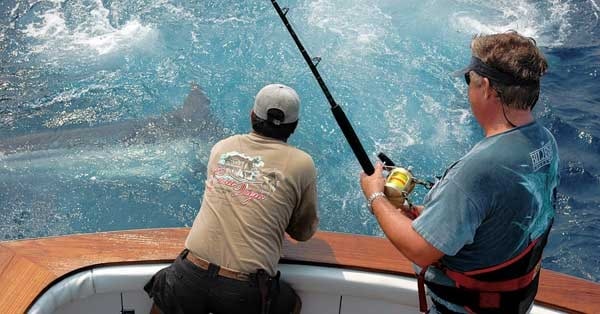
“Harnesses are an integral part of any serious stand-up system for game fish over 50 pounds,” says Temple. “Any beginners with their hearts set on chasing these fish should include a top-of-the-line harness in their lists of stand-up gear.” Good examples include AFTCO’s Maxforce harness or Braid’s Power Play system. Temple also suggests that each angler have his own harness and that he takes time to set it up before he leaves the dock – to avoid rushing around in the cockpit amidst the battle.
Hooking Up and Clipping In
Before you can start the stand-up fight, you have to get hooked up. And that’s where most of the problems begin, according to South Florida charter skipper Ken Harris. Over a 10-year period in the late 1980s and early ’90s, Harris fished giant bluefin tuna off Massachusetts with fellow guides Jose Wejebe, Robert Trosset, Bruce Cronin and Ralph Delph. Together they landed 31 tuna between 500 and 1,200 pounds – all on stand-up gear. Harris, who is also a pro staff member for Braid Products, took what he learned there and adapted it to fishing lighter stand-up gear for triple-digit yellowfin tuna, blue marlin, giant sharks and broadbill swordfish in his home waters off Key West. The system has worked so well for him, he’s translated it into multiple tournament wins, including top prize in the 2000 Drambuie Key West Marlin Tournament. During that event, his then 15-year-old son, Clay, brought a 400-pound blue marlin to leader in under 15 minutes.
For Harris, the most critical time is the first 20 seconds following a strike or knockdown.
“More good fish are lost when people have their heads down, fumbling around either trying to get clipped into the harness or trying to seat the gimbal,” says Harris. “I don’t care how big the tackle or fish is, tough it out for 20 or 30 seconds. Get control of the rod and feel the fish, figure out what you need to do (engage the drag, wind, drop back) before worrying about getting locked into the harness. If you can’t get through that first 20 seconds, nothing else matters.”
Once you’ve gotten the fish settled, it’s time to get down to the business.
The stand-up concept revolves around using your entire body to move the rod tip up and down – the same as pumping and winding in a conventional fishing scenario – to avoid physical strain. With the fish hooked up and moving off, lean into the harness with your back straight, balancing your weight against the resistance of the fish.
The biggest help in reducing the physical strain caused by fighting fish, says Bierman, is mastering the pelvic tilt – keeping your hips tucked under your lower back.
“That tilt is the most important thing to learn when battling big fish on stand-up gear,” says Bierman. “It keeps the lower back from getting strained.”
Place your left hand on the side plate of the reel, with your right hand on the handle. Once the fish stops and you are able to gain line, pivot at the knees, leaning back in the harness until the rod tip rises and it feels like you can wind down and regain line. With the hand on the reel, keep tension between the rod and the harness – and never wind or drop the rod tip fast enough to introduce slack into the line. The left hand can be used to guide line on the reel during the fight to make sure it doesn’t stack up on one side of the spool. In that position, it is also helpful in case of an unexpected break off, preventing the rod from potentially injuring the angler.
“It’s not a very radical movement,” says Harris. “I tell people, ‘Don’t raise the rod tip any higher than your eyeballs.”‘ He likes the rod angle to range from about 15 degrees when the fish is pulling drag, to about a 40 or 45 degrees at the top of the stroke before recovering line.
But Harris is quick to point out that it’s more important for the angler to know what the fish is doing so he can respond accordingly.
“I watch people make the same motion over and over, regardless of what the fish is doing. I call it ‘robo-fishing,'” says Harris. “How can you keep doing the same thing all the time when the fish is doing something different? Sometimes you can lift and gain a lot of line. Other times, it might only be a matter of inches. That’s when it’s up to you to read the fish and get on them. But the angler must always be aggressive.”
Bierman agrees. “It’s important to pace yourself so you don’t wear yourself out early on,” says Bierman. “But if the fish isn’t taking line, you had better be. There should never be any standoffs – they never work in the angler’s favor. Don’t take time out for a drink, to take a little rest or anything. The fish isn’t aware of the time-out rules, and while the angler is in time-out, the fish is going to be hauling his behind off into the deep blue yonder.”
And that’s definitely something you want to avoid.
The Stand-Up Stroke
**
| Resting * Hips tucked under to support lower back * Left hand resting on reel; Right hand ready to gain line * Feet slightly less than shoulder width apart | Pumping * As angler settles into squat, rod tip rises. | Winding * Left hand guiding line on reel; Right hand cranking * As angler rises out of squat, rod tip drops, allowing him to recover line. |
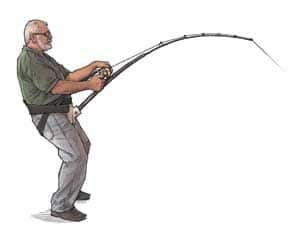
|

|

| **
_Illustrations by Joe Mahler / _www.markerjockey.com
The following manufacturers and retailers specialize in offering gear, tackle and accessories for all levels of stand-up angling:
AFTCO
Harnesses, belts, gloves, accessories
949.660.8757
www.aftco.com
BHP Tackle
Monofilament topshots, wind-on leaders
201.767.9028
www.bhptackle.com
Capt. Harry’s
Retail
800.327.4088
www.captharrys.com
Braid Products
Harnesses, belts, gloves, accessories
www.braidproducts.com
800.716.4558
Daiwa
Rods, reels, line
www.daiwa.com
562.802.9589
Fin Nor Tackle Co.
Rods, reels
www.finnorfishing.com
800.588.9030
Melton Tackle
Retail
800.372.3474
www.meltontackle.com
Penn Fishing Tackle Mfg.
Rods, reels, line
www.pennreels.com
215.229.9415
Shimano
Rods, reels
877.577.0600
www.shimanofishing.com


